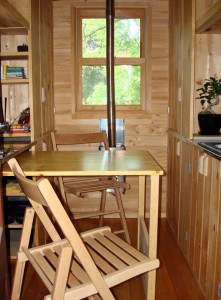Small House Society > Resources > Designing
 Summary. This document offers an overview of lighting considerations for smaller homes. For more information about electrical wiring, read our document on electrical systems for small homes.
Summary. This document offers an overview of lighting considerations for smaller homes. For more information about electrical wiring, read our document on electrical systems for small homes.
Overview. Smaller homes, specifically one-room homes, typically allow for a central room with windows on all walls. The home pictured to the right has windows facing north, south, east, and west. This accommodates natural lighting all day long. Some small homes even have skylights for additional lighting. Plans for additional artificial lighting should take into account the abundance of natural light. In addition, reflective light from walls is recaptured — which isn’t the case in larger homes.
Light Sources. A variety of lighting options are available in smaller spaces that wouldn’t be practical in larger spaces. In fact, halogen lighting and other bright light sources would likely put off too much light (and heat) for a small space. Here are some practical sources of lighting for small homes.
- Bicycle Light. Bicycle headlights were one of the early adopters of LED technology for lighting. They are very bright and efficient. These lights typically produce a lot of light that is generally a focused beam in small spaces.
- Camping Lantern. There are a wide range of LED camping lanterns. These typically run on standard batteries with an option to recharge. They provide wide distribution of light and can fill a small room. Using two or more of these lights in a small home can easily provide all the light you need.
- Candle. In the evening, when you’re getting your body’s inner clock ready to wind down and sleep, the soothing light from a candle is a pleasant way to light a small home. Several candles used simultaneously can put off a large amount of light, but should only be used when you’re still alert enough to turn them off before drifting off to sleep. In the winter, the heat from a few candles helps to warm up a smaller space. Keep in mind that any flame in an enclosed space is burning up oxygen, so candles should be used for short periods of time and/or with some fresh air circulation.
- High Output LED Light. There are now some high output LED light systems that can produce much more light than a typical flashlight. Some models offer switchable light levels for greater light output or less light with more energy efficiency.
Commentary. Below is a commentary from Gregory Johnson.
For lighting my small house, I found that LED camping lanterns and high intensity energy efficient bicycle lights worked quite well. I could use rechargeable batteries in these. In a smaller space, they provided more than enough light to fill the room.
I also had some of those inexpensive LED yard lights that recharge during the day. At night, I would bring them into the house for lighting. I tried that for a while, but found other lights were brighter.
Another factor that seemed to influence my own choice of artificial lighting was my schedule. I was generally sleeping when it was dark and awake when the sun was shining (either at work or at home). Sometimes, in the winter, I’d be working in the evenings when it was dark, either at my office, or doing on-site consulting at someone’s home or business. I also enjoyed eating out. So, during the daytime hours when there was no daylight, I found that I enjoyed being active and social rather than sitting at home. My favorite times at home were during the day when it was bright and sunny outside.
My home had windows on all four walls, with a full glass doorway. So, there was no shortage of natural light.
